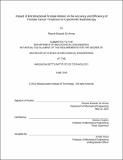| dc.contributor.advisor | Barbara Hughey. | en_US |
| dc.contributor.author | De Armas, Ricardo Eduardo | en_US |
| dc.contributor.other | Massachusetts Institute of Technology. Department of Mechanical Engineering. | en_US |
| dc.date.accessioned | 2015-09-29T18:08:52Z | |
| dc.date.available | 2015-09-29T18:08:52Z | |
| dc.date.copyright | 2015 | en_US |
| dc.date.issued | 2015 | en_US |
| dc.identifier.uri | http://hdl.handle.net/1721.1/98920 | |
| dc.description | Thesis: S.B., Massachusetts Institute of Technology, Department of Mechanical Engineering, 2015. | en_US |
| dc.description | This electronic version was submitted by the student author. The certified thesis is available in the Institute Archives and Special Collections. | en_US |
| dc.description | Cataloged from student-submitted PDF version of thesis. | en_US |
| dc.description | Includes bibliographical references (pages 39-41). | en_US |
| dc.description.abstract | One of the most common treatments for men with localized prostate cancer is radiation therapy, which involves delivering small doses of radiation to the prostate for an extended period of time. Stereotactic-body radiation therapy (SBRT) is a form of radiotherapy that delivers increased dosage to the prostate with more precision. The results are shorter treatment times, increased effectiveness, and less toxicity to surrounding tissue. However, the prostate has been found to move around during treatment (intrafraction) and between treatments (interfraction). With greater precision, there is a greater risk of missing the target while the prostate is moving. This study assesses the impact of intrafractional prostate motion on the accuracy and efficiency of SBRT on CyberKnife. Prostate tracking log files were acquired from 6 patients with prostate cancer, which comprises18 SBRT fractions and 1,892 X-ray image registrations. Each image contains real-time prostate motion in 6D. The data were compared against clinically used margins to identify periods of large prostate motion during treatment. Results indicate significant periods of prostate motion, with the greatest movement occurring in anterior-posterior translation (6.2% outside margin) and pitch rotation (4.3% outside margin). The percentage of prostate motion beyond margins varied among patients, with an average of 12.8% outside clinical margins and 36.0% outside hypothetically reduced margins. The treatment time for each fraction was also recorded to quantify the efficiency of CyberKnife delivery. Because of motion-related delays, optimal setup of 5-15 minutes was seen in only 50% of the fractions, and optimal beam delivery times of 30-40 minutes in 44% of fractions. Thus, results suggest that treatment accuracy and efficiency were negatively affected by the occurrence of large prostate motion. Techniques that immobilize the prostate during treatment may be considered to reduce intrafractional prostate motion and ensure greater accuracy and efficiency of prostate cancer SBRT. | en_US |
| dc.description.statementofresponsibility | by Ricardo Eduardo De Armas. | en_US |
| dc.format.extent | 44 pages | en_US |
| dc.language.iso | eng | en_US |
| dc.publisher | Massachusetts Institute of Technology | en_US |
| dc.rights | M.I.T. theses are protected by copyright. They may be viewed from this source for any purpose, but reproduction or distribution in any format is prohibited without written permission. See provided URL for inquiries about permission. | en_US |
| dc.rights.uri | http://dspace.mit.edu/handle/1721.1/7582 | en_US |
| dc.subject | Mechanical Engineering. | en_US |
| dc.title | Impact of intrafractional prostate motion on the accuracy and efficiency of prostate cancer treatment on CyberKnife radiotherapy | en_US |
| dc.type | Thesis | en_US |
| dc.description.degree | S.B. | en_US |
| dc.contributor.department | Massachusetts Institute of Technology. Department of Mechanical Engineering | |
| dc.identifier.oclc | 921147777 | en_US |
